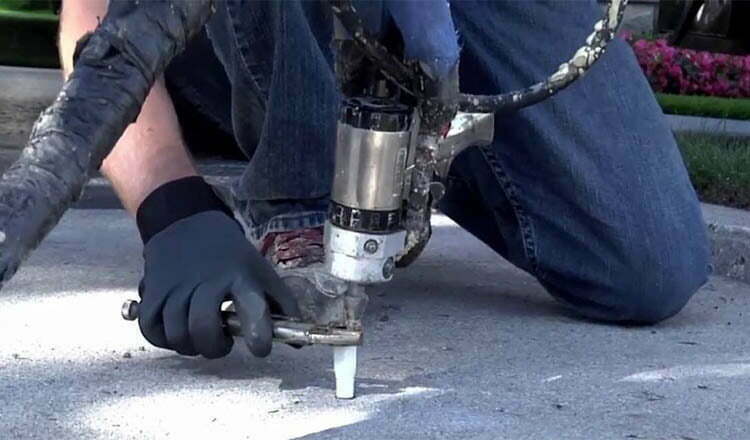Polyjacking is a widely recognized method for stabilizing and lifting concrete surfaces, offering a cost-effective and minimally invasive solution to address issues like sinking or uneven slabs. Whether you’re dealing with a sinking driveway, uneven sidewalks, or a sunken foundation, polyjacking offers a quick and effective solution.
However, one of the most common questions homeowners and property managers have is: how long does polyjacking last? In this guide, we will explore the durability of polyjacking, examining the factors that affect its longevity, and providing essential maintenance tips to ensure you get the most out of this innovative repair technique.
Table of Contents:
- What Is Polyjacking?
- How Long Does Polyjacking Last?
- Factors Affecting the Durability of Polyjacking
- Maintenance and Upkeep of Polyjacking
- Conclusion
What Is Polyjacking?
Polyjacking, a modern concrete repair technique, involves injecting high-density polyurethane foam beneath sunken concrete slabs. This innovative method effectively lifts and stabilizes concrete surfaces, making it an ideal solution for uneven sidewalks, driveways, and commercial floors.
The polyjacking process is relatively simple. Small holes are drilled into the affected concrete, and polyurethane foam is injected into the voids beneath. As the foam expands, it fills the gaps, stabilizes the soil, and lifts the concrete back to its original level. The foam quickly hardens, providing a durable and long-lasting foundation. The materials used in polyjacking are moisture-resistant, ensuring their suitability for long-term applications.
How Long Does Polyjacking Last?
Polyjacking is a long-term solution designed to lift and stabilize sunken concrete. While the average lifespan ranges from 10 to 15 years, many polyjacking projects have demonstrated durability exceeding 20 years, depending on specific conditions.
The longevity of polyjacking is primarily determined by the quality of the polyurethane foam used. This high-density foam is engineered to resist moisture, pressure, and temperature fluctuations, ensuring its stability and durability. Unlike traditional methods like mudjacking, polyjacking foam remains intact and unaffected by erosion or shifting soil.
Polyjacking’s minimally invasive nature also contributes to its longevity. By causing minimal disturbance to the surrounding soil, polyjacking reduces the risk of future settling or sinking. However, several factors can influence the effectiveness and lifespan of polyjacking.
Factors Affecting the Durability of Polyjacking
Several factors influence how long polyjacking lasts. Understanding these variables can help ensure that your investment in this technique delivers the maximum possible lifespan.
Soil Conditions and Stability
The type and stability of the underlying soil are crucial. Compressible, expansive, or erosion-prone soil can lead to shifting and voids beneath the concrete. While polyjacking can address these issues, additional stabilization techniques or drainage improvements may be necessary in such cases.
Weather and Climate
Environmental conditions, particularly moisture and freeze-thaw cycles, can impact the foam’s durability. In fluctuating climates, soil expansion and contraction can stress the slab. Proper drainage around the slab helps mitigate these risks.
Quality of Materials Used
High-quality polyurethane foam is essential for long-term stability. Choosing a contractor who uses premium materials ensures a durable polyjacking project.
Installation Technique
A skilled contractor is crucial for proper injection depth, even distribution, and pressure application. Poor technique can shorten the lifespan of the solution.
Traffic Load and Usage
Heavy traffic or constant foot traffic can stress the foam. While polyjacking is suitable for various applications, areas with excessive use may require maintenance.
Maintenance and Upkeep
Regular inspections, crack sealing, and drainage maintenance are essential for extending the life of polyjacking. Neglecting these can lead to moisture infiltration and reduced effectiveness.
Subsequent Ground Movement
Natural or human-caused ground movement can disrupt the foundation. While polyjacking can accommodate slight movements, significant shifts can compromise the foam’s structural integrity.
Maintenance and Upkeep of Polyjacking
Polyjacking requires minimal maintenance, but regular care can significantly extend its lifespan.
- Regular Inspections: Check your polyjacked surfaces for signs of settling, cracks, or uneven spots. Early detection allows for quick fixes.
- Seal Cracks: Seal cracks to prevent water infiltration, which can weaken the foam.
- Ensure Proper Drainage: Good drainage is essential to prevent soil erosion and maintain stability.
- Avoid Excessive Loads: While polyjacking can handle substantial weight, avoid parking heavy vehicles or equipment on the surface, especially during the curing period.
- Monitor Soil Movement: Address any signs of soil shifting or erosion to maintain stability.
- Seasonal Maintenance: Clear snow and use non-corrosive de-icers in winter. Inspect for cracks and ensure proper sprinkler usage in warmer months.
- Periodic Professional Reassessment: Have a professional check your polyjacked surfaces every few years to detect hidden issues and provide preventive solutions
Conclusion
Polyjacking offers a long-term solution that, with the right conditions and maintenance, can last a decade or more. By choosing a reputable contractor, using high-quality materials, and following routine maintenance practices, you can ensure that your polyjacking project delivers long-term benefits. When done correctly, polyjacking is not just a quick fix but a lasting investment in the stability and safety of your property.
For expert polyjacking services and to learn more about how this innovative technique can benefit your property, contact Ener-Spray today.
